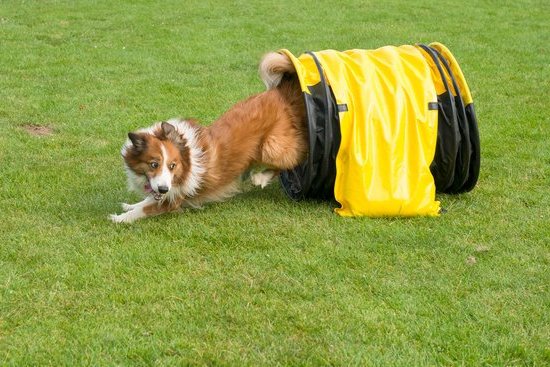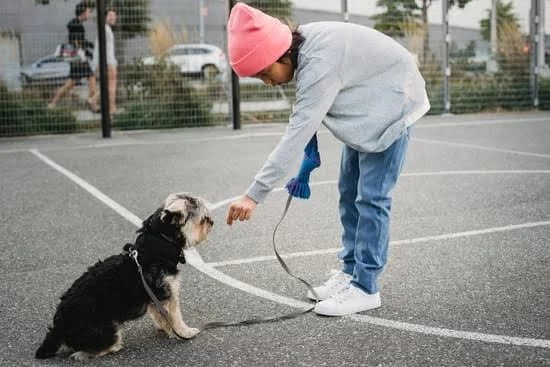Bringing a new dog into your home is an exciting and rewarding experience, but it also comes with its challenges. One of the most important aspects of welcoming a new dog into your family is training. Training your new dog is not only crucial for establishing a harmonious and healthy relationship, but it also benefits both you and your furry friend in numerous ways.
First and foremost, training your new dog is essential for creating a well-behaved and obedient companion. A well-trained dog understands their place in the household hierarchy and knows what behavior is expected of them. This not only makes day-to-day life easier, but it also ensures the safety and happiness of both you and your pet.
Additionally, training helps to strengthen the bond between you and your new dog. Through training sessions, you have the opportunity to spend quality time together, communicate effectively, and build trust. It is an opportunity for both of you to learn from each other, creating a solid foundation for a lifelong companionship.
Not only does training benefit the dog-owner relationship, but it also has positive impacts on your new dog’s overall well-being. Dogs are intelligent creatures that thrive on mental stimulation and structure. Training provides them with mental exercise, which helps prevent boredom and destructive behaviors.
Understanding Your New Dog’s Behavior and Needs
One of the first steps in training your new dog is to understand their behavior and needs. Just like humans, dogs have their own unique personalities and ways of expressing themselves. By learning to read your dog’s body language, you can better understand their emotions and tailor your training approach accordingly.
To start understanding your new dog’s behavior, pay attention to their body language. A wagging tail usually indicates a happy and friendly dog, while a tucked tail may suggest fear or anxiety. Similarly, flattened ears might show submission or fear, while perked ears indicate alertness. By observing these cues, you can communicate more effectively with your dog and respond appropriately to their needs.
It is also important to identify common behavioral issues that new dogs may exhibit. Some dogs may struggle with separation anxiety when left alone, while others may display destructive chewing behavior. By recognizing these challenges early on, you can address them effectively through targeted training techniques or seek professional help if needed.
Once you have an understanding of your new dog’s behavior and needs, you can then proceed with developing a training plan that suits them best. In the next section of this article, we will explore how to set up a training schedule and establish realistic goals for your dog’s training journey.
Setting Up a Training Plan
When bringing a new dog into your home, setting up a training plan is essential for their overall well-being and the success of your relationship. A structured training plan will not only establish clear expectations and boundaries but also provide mental stimulation and promote a harmonious household. Here are some key steps to consider when setting up a training plan for your new dog.
Creating a Schedule and Setting Realistic Goals
Establishing a Consistent Routine
One of the first things you should do when setting up a training plan is to establish a consistent routine for your dog. Dogs thrive on predictability, so having regular feeding times, walks, and training sessions will help them feel secure in their environment. Decide on specific times for training sessions, but keep them short and frequent to maximize learning while preventing boredom or frustration.
Determining Realistic Goals
Before starting any training, it’s important to determine what goals you want to achieve with your new dog. These goals should be realistic and attainable based on your dog’s age, breed, and individual temperament.
For instance, if you have a young puppy, the focus might be on basic obedience commands such as sit, stay, and come. If you have an older rescue dog with behavioral issues, you may need to prioritize addressing those issues before moving onto more complex skills.
The Importance of Consistency and Patience
Consistency is Key
Consistency is crucial when it comes to training your new dog successfully. Dogs learn through repetition and structure, so it’s important that all members of the household are on board with the same set of rules and expectations for the dog. Using consistent cues or commands will help reinforce their understanding of what is expected from them.
An Understanding of Patience
Training takes time and patience; every dog learns at their own pace. It’s important to remain patient and avoid getting frustrated when progress is slower than expected. Dogs are sensitive animals that pick up on their owner’s emotions, so a positive and calm attitude during training sessions will foster a better learning environment.
By setting up a training plan that includes a consistent schedule, realistic goals, consistency in commands, and patience throughout the process, you are laying the foundation for a well-behaved and happy dog. In the next section, we will explore the basic commands you can teach your new dog to further enhance their training journey.
Basic Commands to Teach Your New Dog
Teaching your new dog basic commands is an essential part of their training journey. These commands not only help establish boundaries and discipline but also ensure the safety of both you and your dog in various situations. In this section, we will provide step-by-step instructions for teaching four essential commands: sit, stay, come, and down.
Sit
- Start by holding a treat close to your dog’s nose, allowing them to sniff it.
- Slowly move the treat up and back over their head, which causes their backend to lower as they follow the treat.
- As their backend touches the ground, say “sit” and reward them with the treat.
- Repeat this process multiple times daily until your dog sits on command without needing the treat as a guide.
Stay
- Begin with your dog in a sitting position.
- Hold up your hand flat in front of their face while saying “stay”.
- Take a step backward, maintaining eye contact with your dog.
- If they stay put for a few seconds without moving towards you, return to them calmly and reward them with praise or a treat. Gradually increase the distance as they become more proficient at staying.
Come
- Choose a designated spot or use a long training leash in an enclosed area.
- Squat down, open your arms wide, and call your dog’s name followed by “come” in an enthusiastic tone.
- Encourage them to come towards you by patting the ground or using an excited voice.
- Once they reach you, reward them with praise or treats. Practice this command consistently both indoors and outdoors.
Down
- Ask your dog to sit in front of you initially.
- Hold a treat close to their nose and then slowly lower it straight down towards the ground between their front legs.
- As they follow the treat with their nose, their body should naturally lower into a lying-down position.
- Once they are in a down position, say “down” and reward them. Repeat this command regularly until they respond reliably.
Remember, consistency and patience are key when teaching your dog these basic commands. Always use positive reinforcement techniques such as treats, praise, and petting to reward your dog for successfully following each command. Additionally, keep training sessions short and end them on a positive note to maintain your dog’s interest and motivation.
By mastering these basic commands, you will establish clear communication with your new dog and lay the foundation for more advanced training in the future. Next, we’ll explore how socialization plays a crucial role in your dog’s overall well-being and how to effectively introduce them to new people, pets, and environments.
Socializing Your New Dog
Socialization is a crucial aspect of training your new dog and plays a significant role in their well-being and mental health. By introducing your dog to various people, pets, and environments from an early age, you can help them develop confidence, reduce anxiety, and prevent behavioral issues. In this section, we will explore the importance of socialization and provide strategies for successfully socializing your new dog.
The Importance of Socialization
Proper socialization allows your dog to become comfortable in different situations and interact positively with other animals and humans. It helps build their confidence, reduces fear or aggression towards unfamiliar individuals or environments, and fosters a well-rounded personality. Socialization also enhances their ability to adapt to new experiences throughout their life.
Introducing Your Dog to New People
When introducing your new dog to new people, it’s essential to take things slowly and respect their comfort level. Start by inviting trusted friends or family members into your home one at a time. Encourage visitors to remain calm and avoid overwhelming the dog with too much physical contact or loud noises initially. As your dog becomes more comfortable, gradually expose them to a wider range of individuals with different appearances, including people wearing hats or glasses.
Introducing Your Dog to Other Pets
If you have other pets at home, ensure gradual introductions by allowing them to meet in neutral territory first. Use positive reinforcement techniques such as treats or praise when they display calm behavior around each other. Supervise the interactions closely and separate the animals if any signs of aggression arise. With time and consistent exposure, they will likely develop positive relationships.
Exposing Your Dog to Different Environments
To acquaint your new dog with different environments like parks, busy streets, or public spaces, start with short visits during quiet hours. Gradually increase exposure while maintaining control over the situation through leashes or secure enclosures. Allow your dog time to observe their surroundings and become familiar with the new sights, sounds, and smells. Providing positive reinforcement when they display calm behavior in these environments will further reinforce their positive associations.
By prioritizing socialization in your dog’s training plan, you can lay a strong foundation for a well-adjusted and socially confident companion. Remember to be patient, observe your dog’s body language for any signs of discomfort or fear, and customize socialization experiences to suit their individual needs. With time and consistent effort, you’ll help your new dog develop into a happy and outgoing member of your family.
Addressing Common Training Challenges
Training a new dog can come with its fair share of challenges. Every dog is unique and may present different obstacles during the training process. However, with patience, consistency, and the right techniques, you can overcome these challenges to create a well-behaved and obedient companion. In this section, we will discuss some common training challenges and provide tips to address them effectively.
- Dealing with Stubbornness: Some dogs may be more stubborn than others, making it difficult to get them to follow commands. If your dog is being stubborn, it’s important not to lose your temper or force them into compliance. Instead, try using positive reinforcement techniques such as treats or praise when they exhibit the desired behavior. Break down commands into smaller steps and reward your dog for completing each step correctly.
- Managing Distractions: Dogs can easily get distracted during training sessions, especially in new environments. To address this challenge, start training in a calm and quiet area with minimal distractions. Gradually increase the level of distractions as your dog becomes more focused and comfortable with the training process. Use high-value treats or toys to keep their attention and redirect them whenever they get distracted.
- Curbing Unwanted Behaviors: Dogs may exhibit unwanted behaviors like excessive barking or jumping on guests during training. For barking issues, teach your dog a “quiet” command by rewarding them when they stop barking on command and redirecting their attention to a desirable behavior. To discourage jumping on guests, teach your dog a reliable “off” command that rewards them for keeping all four paws on the ground when greeting people.
Remember that addressing common training challenges requires consistent practice and patience from both you and your dog. It’s important to set realistic expectations and celebrate small victories along the way. Seek guidance from professional trainers if needed and stay committed to providing a nurturing environment where your dog feels safe to learn and grow.
Useful tips to address common training challenges:
- Avoid punishment-based training methods as they can damage your dog’s trust and hinder the learning process.
- Break down commands into smaller steps to make them easier for your dog to understand and follow.
- Keep training sessions short (about 5-10 minutes) and end on a positive note to keep your dog engaged and motivated.
- Practice in different environments to help generalize learned behaviors.
- Stay consistent with commands, cues, and rewards throughout the training process.
By effectively addressing common training challenges, you can overcome obstacles that may arise during the training journey with your new dog. With patience, consistency, and positive reinforcement, you can build a strong bond with your furry friend while creating a well-mannered and obedient companion.
Reward-Based Training
Positive reinforcement is a highly effective and humane training method that relies on rewarding desired behaviors in order to encourage their repetition. This approach focuses on reinforcing good behavior rather than punishing unwanted behavior, making it a more positive and enjoyable experience for both you and your dog. In this section, we will explore the benefits of positive reinforcement in training and provide creative ways to reward and motivate your dog during training sessions.
One of the key benefits of positive reinforcement is that it helps build trust and strengthens the bond between you and your dog. By using rewards such as treats, verbal praise, or playtime, you are creating a positive association with the desired behavior. This encourages your dog to view training as a fun and rewarding activity, leading them to be more enthusiastic and eager to learn.
When using positive reinforcement, it’s important to choose rewards that are highly motivating for your dog. For some dogs, food treats may be the most effective reward while others may be more motivated by toys or praise. Experiment with different types of rewards to see what works best for your furry friend. Additionally, make sure to use rewards consistently and immediately after your dog exhibits the desired behavior. This helps strengthen the association between the behavior and the reward.
Incorporating games into training sessions can also be an effective way to keep your dog engaged and motivated. For example, you can play a game of fetch as a reward for successfully following a command or introduce puzzle toys that dispense treats when certain behaviors are performed correctly. These interactive activities not only provide mental stimulation but also make learning enjoyable for your dog.
| Benefits of Positive Reinforcement | Creative Ways to Reward Your Dog |
|---|---|
| Builds trust and strengthens bond | Use food treats |
| Creates a positive association with training | Offer verbal praise |
| Makes training more enjoyable for both you and your dog | Engage in playtime |
Beyond Basic Training
Once you and your new dog have grasped the basics of obedience training, you may find yourselves eager to explore more advanced skills and tricks. Not only can these advanced training techniques impress your friends and family, but they also provide mental stimulation for your furry friend. This section will guide you through the process of progressing from basic commands to more complex tricks and skills.
To begin teaching your dog advanced skills and tricks, it is essential to establish a strong foundation in basic obedience. Your dog should be proficient in commands such as sit, stay, come, and down before moving on to more advanced training. Consistency and patience are key during this process.
One example of an advanced skill you can teach your dog is “leave it.” This command can be useful in various situations, such as preventing them from gobbling up something off the ground or snatching food from countertops. To start training “leave it,” show your dog a treat in your closed hand and say “leave it.”
As soon as they stop trying to get the treat, praise them and give them a different treat from another hand. Repeat this exercise until they consistently leave the treat alone when told.
Another fun trick to teach your dog is “play dead.” Start by having them lie down on their side, then gently touch their shoulder while saying “bang” or any other word you prefer. Gradually increase the time they stay in that position before rewarding them with treats and praise. With practice, they will learn to stay down until given the release command.
Remember that patience is essential when teaching advanced skills and tricks. Some dogs may pick up new tasks quickly, while others may take longer to master them. Be consistent with your training sessions and always end on a positive note. With time, practice, and lots of rewards, you’ll be amazed at what your well-trained canine companion can achieve.
Maintaining Good Behavior
Once you have successfully trained your new dog and they have mastered the basic commands and skills, it is important to remember that training should not stop there. Ongoing training and reinforcement are crucial for maintaining good behavior in your dog and strengthening their obedience.
Consistency is key when it comes to ongoing training. Dogs thrive on routine, so it is important to continue practicing their learned commands and skills on a regular basis. This will help reinforce their understanding of what is expected of them and keep their behavior consistent.
Incorporating training into your everyday routine can help make it easier to maintain good behavior. Take advantage of everyday situations such as mealtime, walks, or playtime to practice commands with your dog. For example, before feeding them their meals, ask them to sit or stay until you give them the signal that it’s okay to eat. By doing this consistently, your dog will associate these activities with the commands they have learned.
Positive reinforcement is a powerful tool for ongoing training and reinforcement. Continue using treats, praise, and rewards to motivate your dog and reinforce desired behaviors. Remember that consistency is important here too – reward your dog every time they exhibit the desired behavior, so they understand that this behavior is always rewarded.
Overall, ongoing training and reinforcement play a vital role in maintaining good behavior in your new dog. By practicing their learned commands regularly, incorporating training into daily routines, and continuing with positive reinforcement techniques, you can ensure that your dog’s obedience remains strong over time. This continuous training will strengthen the bond between you and your furry friend while keeping them happy, healthy, and well-behaved throughout their life.
Conclusion
In conclusion, training your new dog is not only essential for a harmonious and healthy relationship, but it also brings immense joy and fulfillment. By investing time and effort into understanding your dog’s behavior and needs, setting up a training plan, teaching basic commands, socializing them, addressing common challenges, utilizing positive reinforcement, advancing their skills, and maintaining good behavior through ongoing training and reinforcement, you are creating a strong foundation for a lifelong bond with your furry friend.
Having a well-trained dog not only benefits you as the owner but also greatly enhances your dog’s quality of life. A trained dog is more confident, well-behaved, and obedient.
They are able to understand what is expected of them in various situations, which in turn reduces stress and anxiety. This not only leads to more enjoyable interactions with your pet but also makes everyday activities such as walks or trips to the vet much easier and less stressful for both of you.
Furthermore, training your new dog fosters trust and deepens the bond between you. Through positive reinforcement techniques and consistent training efforts, you are building mutual respect and understanding. Your dog learns to trust your guidance and looks to you for guidance in navigating the world around them. This sense of trust creates a strong emotional connection between you as companions that can bring immeasurable joy and fulfillment.
So don’t wait any longer – start your training journey with your new furry friend today. The effort put into training will be rewarded tenfold with a well-behaved dog who brings happiness into every aspect of your life.
Take the time to understand their needs, be patient yet consistent in your approach, use positive reinforcement techniques to build trust, and continue training as an ongoing process. With dedication and love, you can create an unbreakable bond with your new dog that will bring years of joy and companionship.
Frequently Asked Questions
What are the 5 golden rules of dog training?
While there are various dog training methods and techniques, the five golden rules of dog training serve as a helpful foundation. The first rule is consistency, meaning that dogs learn best when expectations and commands remain constant. Secondly, positive reinforcement should be used to reward desirable behaviors and encourage repetition. The third rule is to start small, gradually increasing difficulty as the dog progresses in their training.
Patience is key here. The fourth rule emphasizes clear communication through verbal cues and body language. Lastly, it is important to end each training session on a positive note to keep the dog engaged and eager for future sessions.
What is the first thing to teach a new dog?
When welcoming a new dog into your home, it is crucial to prioritize teaching them basic obedience commands as the first step. The most essential command is often “sit.”
Teaching a new dog to sit reinforces impulse control, creates focus and establishes an overall groundwork for more advanced training. By consistently practicing this command with rewards such as treats or verbal praise, dogs quickly learn that sitting results in positive outcomes and will begin to respond accordingly.
How long does it take for your dog to get used to a new dog?
The length of time it takes for a dog to get used to a new dog varies depending on various factors such as temperament, past experiences, and individual personalities of both dogs involved. It can take anywhere from a few days to several weeks for the dogs to become acclimated with each other’s presence and develop a harmonious relationship. Patience from the owner during this period is essential.
Introductions should be done gradually, allowing the dogs controlled interactions while closely monitoring their behavior for signs of comfort or distress. Building trust between the two dogs may require multiple supervised meetings before they become fully adjusted around each other.

Welcome to the blog! I am a professional dog trainer and have been working with dogs for many years. In this blog, I will be discussing various topics related to dog training, including tips, tricks, and advice. I hope you find this information helpful and informative. Thanks for reading!





